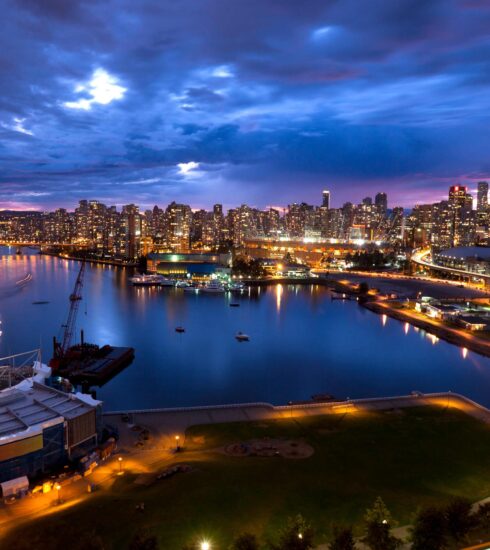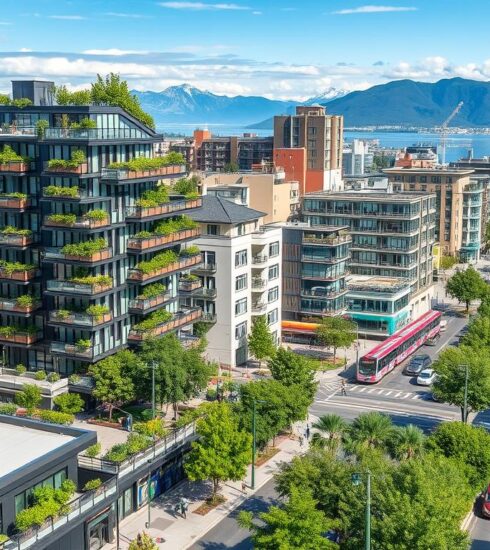Shaping Tomorrow: The Role of Urban Design in Building Resilient Cities
- Jackie De Burca
- November 18, 2024
As cities across the United States undergo a profound transformation, urban design has emerged as a crucial factor in fostering resilient and vibrant environments. The evolution of American cities has been marked by significant changes, driven by economic advancement, technological progress, and shifting societal needs1. CBRE’s analysis of real estate implications offers valuable insights into shaping the future of cities, including a mapping tool that identifies urban characteristic clusters across various districts. Through this lens, cities can be categorised into four distinct archetypes: Super Cities, Mixed Majors, Sprawling Darlings, and Developing Destinations, each with unique economic, demographic, and urban development factors1.
The current transformation of American cities, particularly the rise of remote working, represents a new phase in their development1. Urban growth has accelerated in the 21st century, following a renaissance that began in the 1990s1. However, the COVID-19 pandemic has also led to urban migration, with residents moving to suburban areas1. This shift has had a profound impact on the commercial real estate sector, with a rise in vacancy rates and unpredictable trends in office property demand1.
Key Takeaways
- Urban design plays a crucial role in fostering resilient and vibrant environments.
- Cities are categorised into four archetypes based on economic, demographic, and urban development factors.
- The COVID-19 pandemic has led to urban migration and changes in the commercial real estate sector.
- Stakeholders are encouraged to engage in urban planning to stimulate development and drive positive change in cities.
- Sustainable urban planning is a significant challenge, requiring a focus on resilient infrastructure and a high quality of life for residents.
Understanding Urban Design and Its Importance
Urban design encompasses the planning and shaping of cities to create sustainable, resilient, and equitable living spaces2. The United Nations Habitat defines urban resilience as the measurable ability of any urban system and its inhabitants to maintain continuity through all shocks and stresses while positively adapting and transforming toward sustainability2. The United Nations Office for Disaster Risk Reduction (UNISDR) further describes urban resilience as the ability of a hazard-exposed system, community, or society to resist, absorb, adapt, transform, and recover from the effects of a hazard in a timely and efficient manner2.
Definition and Scope of Urban Design
Urban design is a multidisciplinary field that combines architecture, landscape architecture, urban planning, and other disciplines to create functional, visually appealing, and socially inclusive environments3. Placemaking and urban design enhance the quality of urban environments by fostering connections between people and the places they share3. Placemaking strengthens communities by encouraging community participation in designing public spaces3.
Historical Context of Urban Development
The historical context of urban development in the United Kingdom shows a shift from suburban growth in the late 20th century to an urban renaissance in the 21st century. This renaissance was driven by millennials and baby boomers seeking walkable live-work-play environments3. However, the COVID-19 pandemic disrupted this trend, leading to increased suburban migration and challenges for commercial real estate. The success of future cities depends on identifying strengths and weaknesses to inspire reinvention and maintain economic power and competitive advantage.
| Biophilic Design Principles | Smart City Technologies |
|---|---|
| Incorporating natural elements, such as plants and water features, into urban environments to enhance human well-being and connection with nature. | Integrating digital technologies, such as sensors, data analytics, and automation, to improve the efficiency and sustainability of urban systems, including transportation, energy, and waste management. |
| Designing built environments that mimic natural patterns and processes, creating a sense of harmony and balance. | Leveraging data and technology to enhance urban planning, decision-making, and citizen engagement, leading to more responsive and resilient cities. |
| Promoting the use of natural materials, natural lighting, and natural ventilation in building design to reduce energy consumption and improve indoor environmental quality. | Enabling the integration of renewable energy sources, smart grids, and energy-efficient buildings to reduce carbon emissions and increase sustainability. |
“Placemaking and urban design offer a framework for creating resilient and vibrant urban spaces, essential for future livability and inclusivity.”3
The success of future cities depends on identifying their strengths and weaknesses to inspire reinvention and maintain economic power and competitive advantage3. Urban design and placemaking integrate arts, culture, and entertainment into public spaces, stimulating local economies and attracting visitors3. Well-designed public spaces can increase property values, attract investments, and boost economic development3.
Key Principles of Resilient Urban Design
Resilient urban design focuses on creating cities that can withstand and adapt to various challenges, from climate change to natural disasters and population growth4. This holistic approach prioritises sustainability, inclusivity, and accessibility to foster urban environments that are better equipped to handle acute shocks and chronic stresses5.
Sustainability and Green Architecture
Incorporating green spaces, sustainable infrastructure, and community engagement are key aspects of resilient urban design4. Principles such as redundancy, diversification, flexibility, and ecological integration guide the development of resilient cities4. Examples include the integration of flood zones into parks to hold excess water during heavy rain, and the use of adaptive structural design and sustainable materials in resilient architecture4.
Inclusivity and Accessibility
Inclusive design ensures that urban spaces cater to the diverse needs of the community, fostering a sense of belonging and empowerment5. Strategies like public transportation integration, mixed-use development, and the incorporation of green infrastructure contribute to both sustainability and social equity4. Technological advancements, such as the Internet of Things (IoT), also play a role in enabling better data collection and monitoring to support resilient urban design4.
Resilient urban design is a holistic approach that aims to create cities capable of withstanding and adapting to a wide range of challenges5. By prioritising sustainability, inclusivity, and accessibility, urban planners can build communities that are better equipped to thrive, regardless of the acute shocks and chronic stresses they face5.
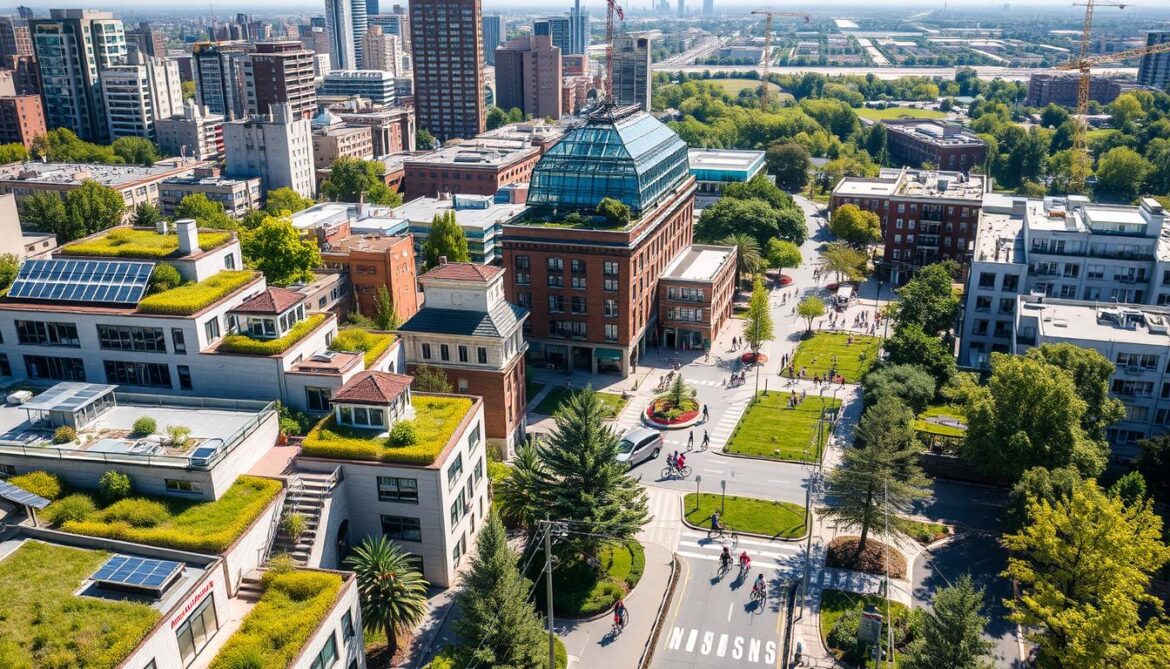
“Resilient urban design emphasizes the importance of redundancy, modular design, and resilient infrastructure to ensure cities can withstand and adapt to future challenges.”4
Integrating Nature into Urban Spaces
As cities continue to expand and urbanisation intensifies, the need to integrate nature into our built environments has become increasingly paramount6. Nature-based Solutions (NbS) can play a pivotal role in addressing a myriad of societal challenges, from food security and climate change to water security and human health6. Cities worldwide are increasingly recognising the benefits of incorporating green infrastructure into their urban planning, as evidenced by the successes of urban centres like Vancouver, Canada6.
Benefits of Urban Greenery
The integration of nature into urban spaces offers a wealth of advantages7. Green infrastructure can improve air and water quality, mitigate the urban heat island effect, support biodiversity, and enhance overall urban resilience7. Furthermore, access to green spaces has been linked to improved mental well-being, increased physical activity, and a higher quality of life for urban residents7.
From the addition of trees to the implementation of green roofs and rain gardens, nature-based solutions can effectively cool urban areas, manage stormwater, and create vibrant, liveable communities7. These green infrastructure elements not only address environmental challenges but also contribute to the aesthetic appeal and overall sustainability of our cities7.
Examples of Successful Green Spaces
One shining example of integrating nature into urban spaces is Vancouver’s Greenest City Action Plan6. This comprehensive strategy sets ambitious targets for carbon emissions reduction, zero waste, and ecosystem protection, with a strong focus on urban greenery6. Vancouver’s Urban Forest Strategy and Green Buildings Program demonstrate how cities can effectively incorporate nature into their urban fabric6, yielding benefits that extend far beyond environmental sustainability.
Across the globe, cities are embracing the power of green infrastructure solutions to address pressing challenges8. Investments in nature-based infrastructure can be up to 42% cheaper and create 36% more value than traditional grey infrastructure8, while generating up to 30 times the initial investment in returns for society8. These success stories highlight the transformative potential of integrating nature into our urban landscapes, paving the way for more sustainable, resilient, and liveable cities.
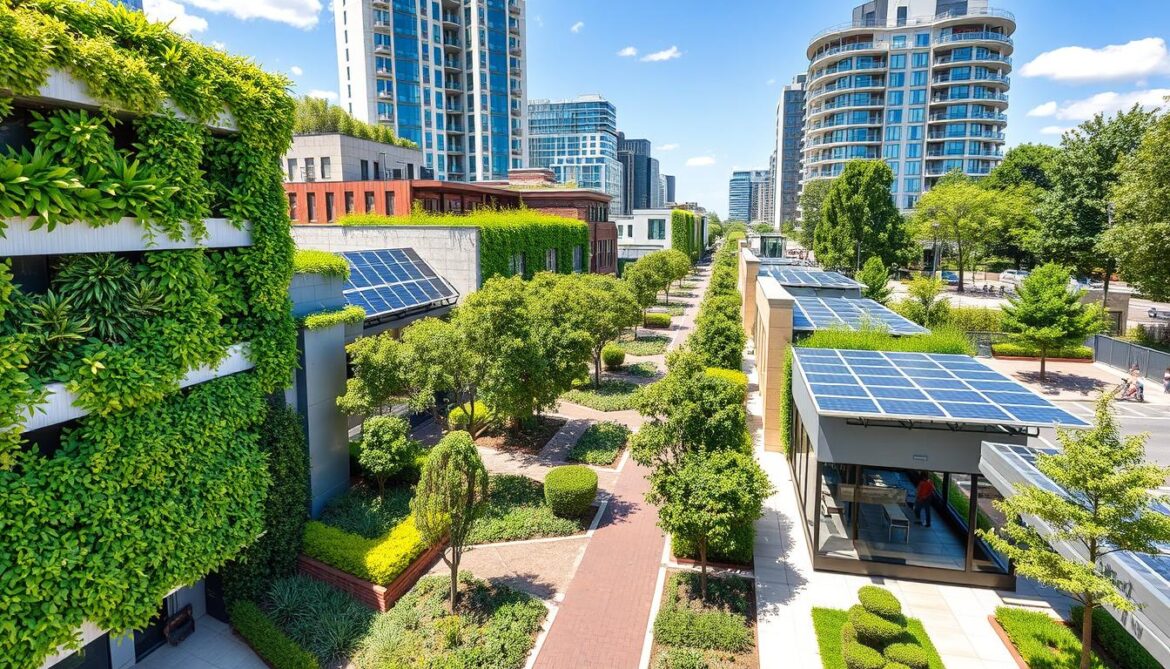
“Integrating nature into our cities is not only a sustainable and cost-effective solution, but it also enhances the overall well-being of urban communities. By embracing green infrastructure, we can create vibrant, liveable spaces that benefit both people and the planet.”
The Impact of Climate Change on Urban Planning
Climate change poses significant challenges to urban planning, necessitating adaptive strategies to cope with extreme weather events. Cities around the world are taking bold steps to build climate-resilient infrastructure and reduce disaster risk9.
Adapting to Extreme Weather Events
Urban design strategies can play a crucial role in mitigating the effects of climate change. For instance, the transportation sector may account for as much as 40% of community-level mitigation measures in urban planning9. Additionally, urban design can reduce the need for air conditioning, a significant source of carbon emissions9. The cooling impact of a single healthy tree is equivalent to ten room-size air conditioners running 24 hours a day, highlighting the benefits of incorporating urban greenery9.
Case Studies of Resilient Cities
Cities around the world are leading the way in building climate-resilient infrastructure. Rotterdam, Netherlands, has become a beacon of resilience in the face of rising sea levels. The city’s comprehensive approach to water management includes innovative flood protection measures and climate-proof urban design9. The Rotterdam Climate Initiative exemplifies how cities can balance environmental sustainability with economic prosperity while adapting to climate change impacts.
Other cities are also taking innovative steps to become more resilient. Newfield in Martin County, Florida, is an example of greenfield growth that requires sustainable planning, as it is located 10 miles from the vulnerable southeast coast9. Different regions of the United States have unique vulnerabilities to climate change, and regionally-specific climate change planning will be crucial for mitigating the effects on urban areas9.
| City | Resilient Approach |
|---|---|
| Rotterdam, Netherlands | Comprehensive water management, innovative flood protection, climate-proof urban design |
| Newfield, Martin County, Florida | Sustainable planning for greenfield growth near vulnerable coastline |
| Various US Regions | Regionally-specific climate change planning to address unique vulnerabilities |
The migration process due to climate change will impact growth and demographics across the US for generations, creating significant opportunities for urban designers to shape this process9. For instance, the rapid population growth in Hammond, Louisiana, after Hurricane Katrina demonstrates the importance of proactive urban planning in the face of climate-related disasters9.
“A neighbourhood with stronger social connections experienced reduced mortality during an extreme heat event in 1995 compared to another nearby area.”
This quote highlights the crucial role that social ties in neighbourhoods can play in building resilience to climate change impacts9.
Technological Innovations in Urban Design
Technological innovations are transforming urban design, enabling the creation of smart cities that enhance efficiency, connectivity, and quality of life10. The Urban Risk Management and Resilience Strategy by UNDP recognizes the potential of digital technologies in reshaping urban futures, particularly in addressing heatwaves and heat island effects in vulnerable communities10. Initiatives include using cutting-edge technology and data analytics to identify hotspots, implement early warning systems, and reduce risks related to heatwaves in cities10.
Smart Cities: Leveraging Technology for Resilience
Seoul, South Korea, stands out as a global leader in digital innovation, with ubiquitous Wi-Fi coverage, integrated smart grids, and innovative e-government services10. The Seoul Digital Plan and Seoul Innovation Strategy demonstrate how technology can be harnessed as a catalyst for inclusive growth and sustainable urban development10. UNDP supports urban resilience projects globally, such as mapping water stream confluences in Serbia and mitigating climate-induced water stress in Kyrgyzstan using GIS technologies10.
The Role of Data in Urban Planning
Data-driven decision-making and digital infrastructure optimise resource allocation and improve service delivery in modern cities10. UNDP collaborates with governments, the private sector, tech entities, research organizations, people with disabilities, women, and youth to expand digital technologies’ application in building resilient and thriving cities10. In Kosovo, a partnership with UrbanistAI leverages AI for public involvement in urban planning and decision-making to build resilient cities10.
The foundational technologies for cities include cloud computing, data analytics, mobile communications, and social applications11. Technology infrastructure is crucial for cities to grow along with population growth and land expansion, highlighting the need for ubiquitous coverage of affordable, high-speed internet11. Technology plays a significant role in preparing for and monitoring the local impacts of climate change through sensors and data analysis applications11.
The ability to collaborate globally and share best practices is enhanced by technology, aiding cities in identifying and sourcing products and services from around the world to solve local needs11. The design of resilience initiatives aims to manage the risks of shocks while reducing chronic stresses, fostering safer and healthier environments11.
Cities that invest in technology now are better positioned to offset future impacts, making infrastructure investments that enhance urban resilience11. To harness technology effectively, cities need foundational infrastructure such as high-speed internet, cloud computing capabilities, data functionality, and cybersecurity defences11.
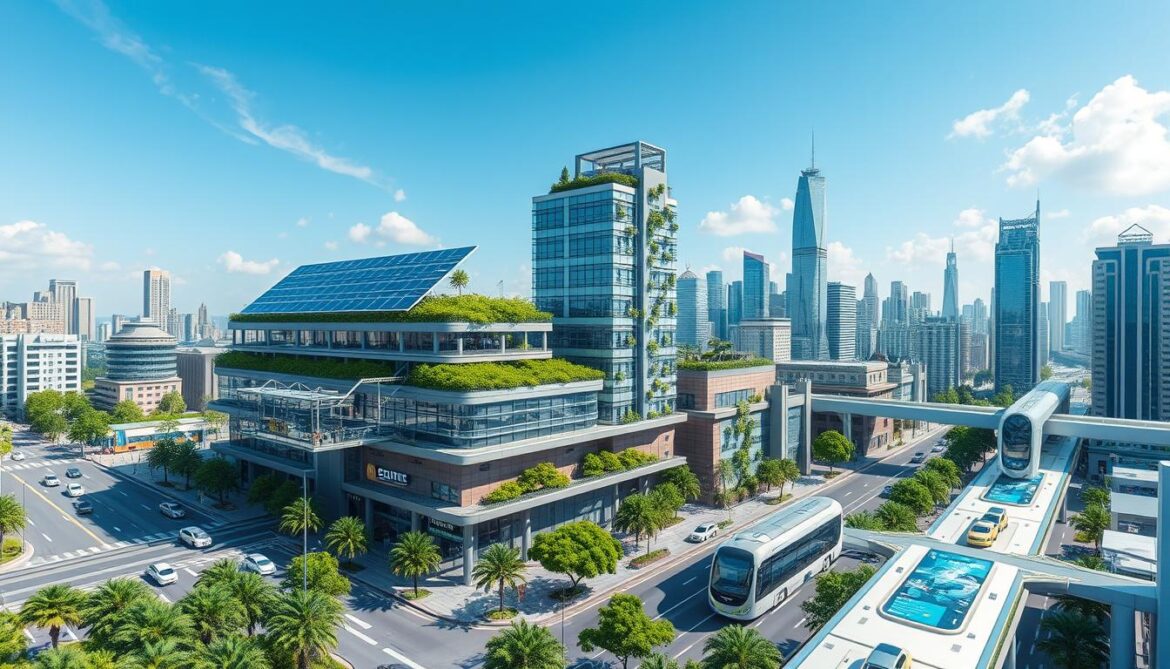
“Technology is increasingly important in understanding and mitigating shocks and stresses, with new products and services advancing due to emerging technologies like cloud computing, data analytics, and social applications.”11
Urban resilience and technology are converging as cities define resilience challenges and evolve technologies to address them11. Use cases are critical for the successful application of technology-based solutions to mitigate resilience challenges, with city business processes providing potential areas for technology application11.
Community Engagement in Urban Design
Inclusive and responsive urban environments thrive when cities prioritise community engagement. Barcelona, Spain, exemplifies this ethos, where collaborative governance drives urban transformation and citizen empowerment12. Barcelona’s participatory budgeting initiatives, neighbourhood councils, and civic engagement platforms enable residents to actively shape the future of their communities13. The Barcelona Metropolitan Strategic Plan and Sharing Cities Programme showcase a holistic approach to urban development that prioritises social inclusion, environmental sustainability, and economic prosperity through active community involvement.
Importance of Local Input
Community engagement is crucial for sustainable and equitable urban planning12. Research indicates that community engagement in urban planning can lead to waste management systems that are more effective and eco-friendly12. Studies highlight that resource exploitation tends to be inefficient and unsustainable when communities are excluded from the governance of mineral resources12. Technology such as geolocation data, online platforms, and data analytics are utilised in modern urban planning to enhance community engagement12. Diversity, Equity, and Inclusion (DEI) initiatives contribute to broader perspectives, social equity, and enhanced trust in urban planning processes.
Workshops and Collaborative Design
Community involvement in urban design fosters a sense of ownership and investment in the city’s future13. Initiatives with high levels of community involvement result in increased citizen satisfaction and improved project outcomes13. Public participation in urban planning led to better service delivery, according to a World Bank study13. Community engagement fosters social cohesion, trust, transparency, and accountability in decision-making processes13. Collaborative strategies in community engagement foster communal bonds, social cohesiveness, and lead to a more resilient and inclusive society13.
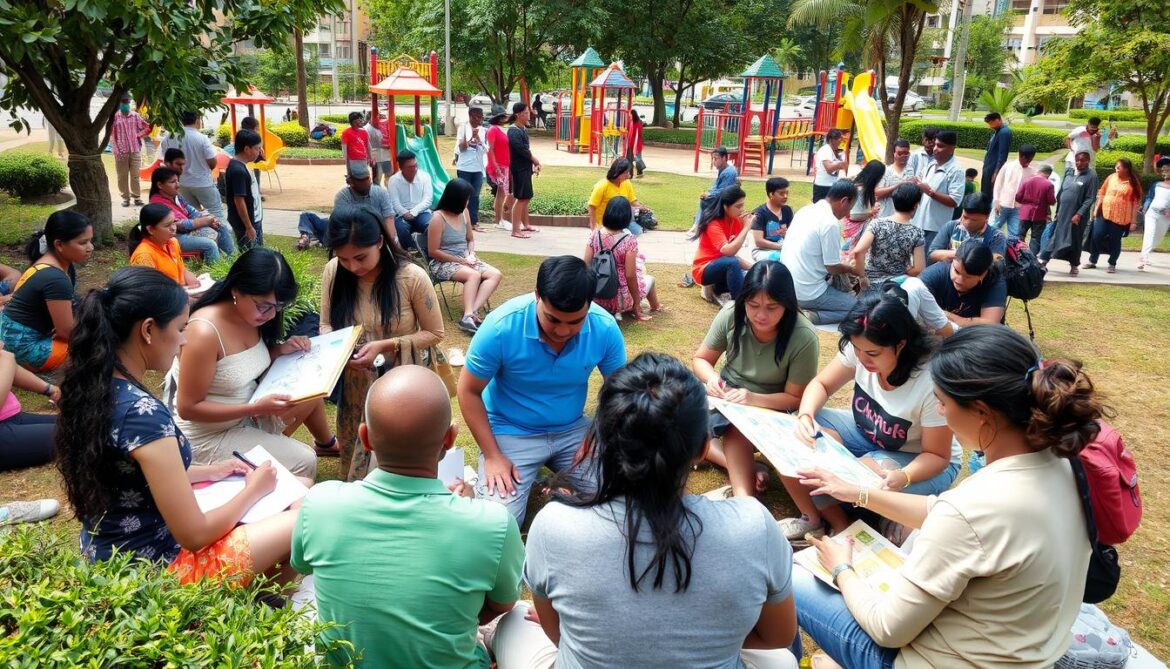
“Community engagement in urban planning is essential for creating inclusive, responsive, and sustainable cities. By empowering residents to shape the future of their neighbourhoods, cities can foster a sense of ownership, social cohesion, and long-term resilience.”
| Community Engagement Strategies | Benefits |
|---|---|
| Participatory Budgeting | Increased citizen satisfaction, improved project outcomes, and better service delivery. |
| Neighbourhood Councils | Enhanced social cohesion, trust, transparency, and accountability in decision-making. |
| Civic Engagement Platforms | Broader perspectives, social equity, and increased trust in urban planning processes. |
By embracing community engagement strategies, cities can foster walkability and accessibility, ensure social inclusion, and build resilience in the face of urban challenges14. The integration of local input and collaborative design processes is key to creating sustainable, liveable, and equitable urban environments121314.
Policies and Regulations Shaping Urban Resilience
Sustainable urbanism and compact city planning are crucial in building resilient cities that can withstand the challenges posed by climate change and urban growth. Governments around the world are taking proactive steps to implement policies and regulations that support sustainable development and enhance urban resilience15.
Government Initiatives for Sustainable Development
One notable example is Singapore’s Urban Redevelopment Authority (URA), which has implemented strategic land use planning and rigorous zoning regulations to transform the city-state into a model of sustainable urban development15. Similarly, Copenhagen’s Climate Adaptation Plan and Bicycle Strategy have set benchmarks for environmentally conscious urban development, balancing economic growth with environmental protection and social equity15.
Zoning Laws and Their Impact
Zoning laws play a crucial role in shaping urban resilience by dictating land use, density, and building specifications. Effective policies can integrate history and innovation, as seen in McGregor Coxall’s implementation of the ‘modular mile’ for London’s ExCeL Phase 3 redevelopment16. This adaptable public realm design uses reconfigurable modules and a pontoon system to connect people with the Royal Dockland waterfront, promoting dynamic experiences16.
Similarly, plans for Bristol’s YTL Arena aim to transform a traditional site into a multifaceted cultural space, incorporating environmental and ecological improvements such as bioretention zones16. The Powerhouse Parramatta Museum in Sydney, a regenerative waterscape project influenced by local ecology and community engagement, represents a significant cultural investment by the NSW Government16.
The integration of cultural heritage into adaptive design strategies is highlighted as a crucial pathway towards resilient, inclusive, and environmentally conscious urban environments16. This is exemplified by McGregor Coxall’s landscape design for the Art Gallery of NSW’s Sydney Modern Expansion, which focuses on facilitating connections between people and place, incorporating native planting and rare species to honor indigenous practice, and achieving a 6-star Green Star sustainability rating16.
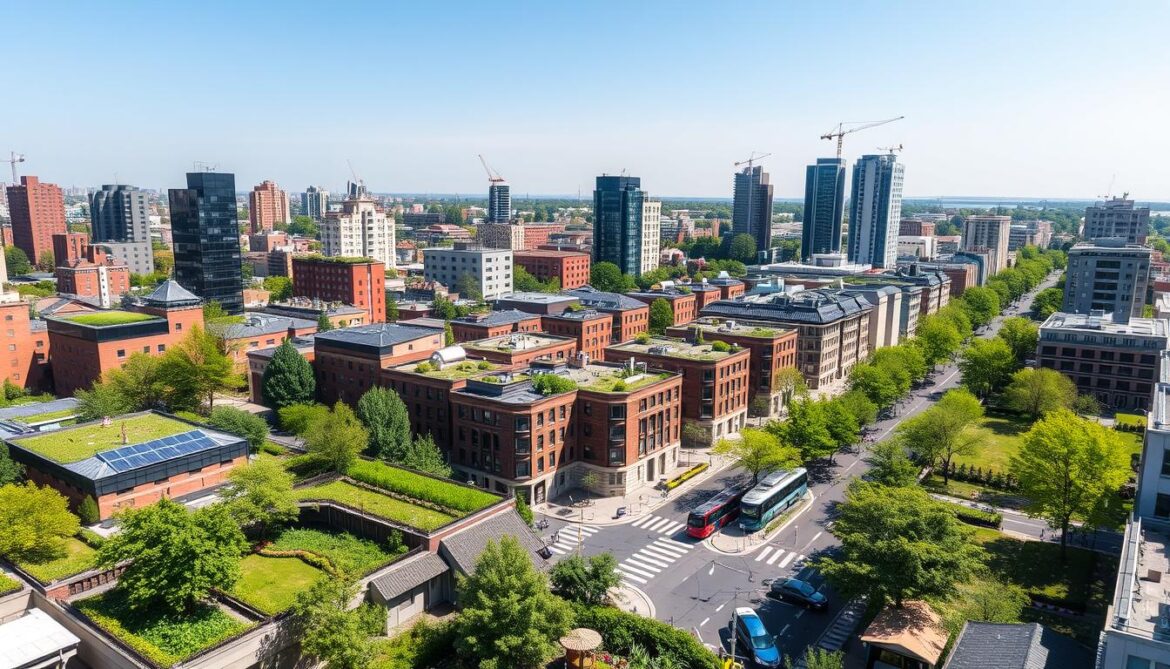
“Policies and regulations play a crucial role in shaping urban resilience and sustainable development. Effective policies balance economic growth with environmental protection and social equity.”
Governments worldwide are taking a proactive approach to implementing policies and regulations that support sustainable urbanism and compact city planning, recognizing their importance in building resilient cities that can adapt to the challenges of the future15.
Challenges in Implementing Resilient Design
Implementing resilient urban design faces a myriad of challenges, from economic constraints and funding issues to social and cultural barriers. As the world grapples with the unprecedented rise in office vacancy rates, exacerbated by the COVID-19 pandemic and higher interest rates, the path to sustainable development has become increasingly arduous17.
Yet, the urgency for action has never been more palpable. The discussion around urban resilience is expected to grow due to climate change leading to larger and longer-lasting disasters, more frequent threat incidents, and extreme weather-related events17. Furthermore, global urbanisation trends indicate an increasing proportion of the world’s population resides in urban areas, putting more people at risk and emphasising the need for urban resilience17.
Economic Challenges and Innovative Funding
One of the primary obstacles in implementing resilient design is the economic constraints and funding issues that cities face. The COVID-19 pandemic and higher interest rates have exacerbated the challenge, with a notable increase in office vacancy rates17. Overcoming these financial hurdles requires innovative funding mechanisms, such as public-private partnerships and creative financing solutions, to support the development of resilient infrastructure and green spaces.
Social and Cultural Barriers
Alongside economic barriers, social and cultural factors can also hinder the implementation of resilient urban design. Resistance to change, divergent priorities, and a lack of community engagement can create significant roadblocks17. Addressing these challenges necessitates inclusive engagement strategies that actively involve diverse community members, addressing their concerns and aligning resilience efforts with their needs and aspirations.
| Challenges | Strategies |
|---|---|
| Economic Constraints and Funding Issues | Innovative funding mechanisms, public-private partnerships, creative financing solutions |
| Social and Cultural Barriers | Inclusive community engagement, aligning resilience efforts with diverse needs and concerns |
To overcome these hurdles, cities must adopt a holistic approach that combines innovative funding, community engagement, and a deep understanding of the unique social, cultural, and economic factors at play. By addressing these challenges head-on, urban planners and policymakers can pave the way for the creation of truly resilient and sustainable cities18.
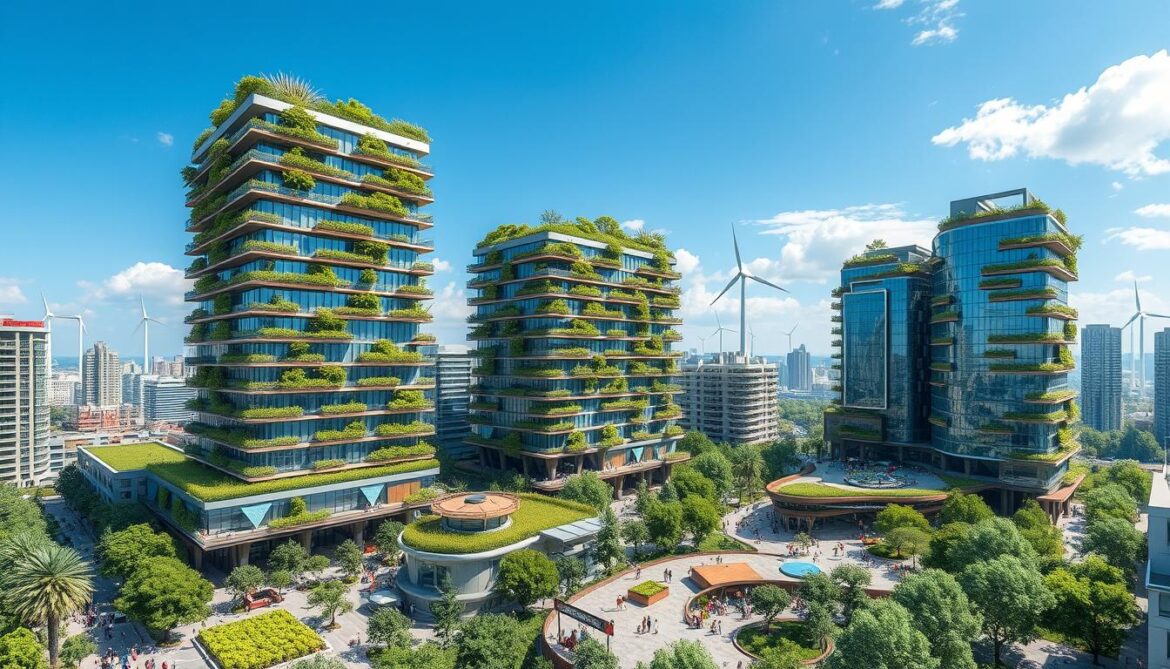
“Resilience is not just about bouncing back, but also about anticipation and transformation. It’s a complex, multifaceted concept that requires a comprehensive, integrated approach.”
As the world grapples with the increasing frequency and intensity of disasters, the need for resilient urban design has become paramount. By overcoming the economic, social, and cultural barriers, cities can unlock the potential of Disaster Risk Reduction and Community Engagement Strategies to build a more sustainable and resilient future1718.
Future Trends in Urban Design
As cities continue to grow and evolve, urban design is poised to play a pivotal role in shaping the cities of tomorrow. The future of urban design is marked by a heightened focus on sustainable growth and innovative infrastructure solutions that prioritise the well-being of residents19.
Prediction of Urban Growth Patterns
Urban planners foresee a continued emphasis on compact city planning and mixed-use developments, which can reduce dependency on automobiles and foster more vibrant, inclusive communities20. Singapore, for instance, tops the Green View Index for its impressive canopy cover, setting a benchmark for cities aspiring to incorporate more green spaces19.
Innovations in Transportation Infrastructure
Advancements in transportation infrastructure, such as Curitiba’s renowned Bus Rapid Transit (BRT) system, are revolutionising urban mobility and providing efficient, affordable transit options19. Furthermore, integrating smart city technologies and data-driven planning will enable cities to optimise their transportation networks, reducing carbon emissions and improving accessibility20.
The integration of green infrastructure solutions, such as green walls and roofs, is another emerging trend that enhances air quality, energy efficiency, and the overall liveability of urban spaces20. Mayors, like Yvonne Aki-Sawyerr of Freetown, are leading the charge in urban greening initiatives, aiming to increase vegetation cover by 50% through planting one million trees by 202219.
As cities strive for greater sustainability and resilience, the role of technology in urban design is becoming increasingly prominent. Smart grid technology, for instance, is being utilized to develop more effective and sustainable energy systems20, while the integration of data-driven planning is enabling cities to make more informed decisions and respond to the evolving needs of their communities20.
The future of urban design is not just about physical infrastructure but also about prioritising the health and well-being of urban residents. Cities are moving towards healthcare ecosystems that focus on supporting overall well-being through early intervention and prevention, with advancements in personalised healthcare19. This shift reflects a growing understanding that the design of our cities can have a profound impact on public health, with five of the top ten causes of death globally related to unhealthy behaviors19.
As cities navigate the challenges of the future, the integration of smart city technologies and green infrastructure solutions will be crucial in creating urban environments that are sustainable, resilient, and improve the quality of life for all residents20.

Success Stories: Cities Leading the Way
Around the world, cities are embracing resilient urban design strategies to combat the challenges posed by climate change and create sustainable environments for their communities. From Copenhagen’s commitment to cycling infrastructure and renewable energy to Curitiba’s innovative public transportation system, these success stories offer valuable lessons for cities seeking to enhance their resilience21.
Examples of Resilient Urban Design Projects
Singapore’s comprehensive urban planning and Vancouver’s green initiatives showcase the potential for balancing development with environmental stewardship. In Melaka, Malaysia, a high-tech smart energy grid system with renewable energy sources is being piloted, while the GEF project in Chennai, India, aims to restore Kadapakkam Lake for recreational and inclusive facilities21. Across the globe, cities are leading the way in sustainable urbanism, demonstrating the transformative power of resilient design22.
Lessons Learned from Global Cities
These success stories provide valuable insights for other cities striving to enhance resilience and sustainability in their urban design strategies. From Wuhan’s sponge city initiative, which saved more than US$600 million compared to upgrading its drainage system, to Tokyo’s Tunnel and Reservoir Network (TRN), which has prevented over 12 floods and saved 32 regions from land subsidence, the lessons learned can be applied to urban centres worldwide23. As the global population continues to urbanise, these pioneering examples offer a blueprint for creating cities that are not only liveable but also adaptable to the changing climate22.
FAQ
What is the role of urban design in building resilient cities?
How has the historical context of urban development in America evolved?
What are the key principles of resilient urban design?
How can integrating nature into urban spaces contribute to sustainable and liveable cities?
How are cities adapting to the challenges posed by climate change?
How are technological innovations transforming urban design?
What is the role of community engagement in shaping inclusive and responsive urban environments?
How do policies and regulations impact urban resilience and sustainable development?
What are the challenges in implementing resilient urban design?
What are the future trends in urban design?
Source Links
- Shaping Tomorrow’s Cities: Fostering Resilient and Vibrant Urban Environments – https://www.cbre.com/insights/books/shaping-tomorrows-cities
- Building Sustainable and Future-Proof Cities – https://www.e-zigurat.com/en/blog/urban-resilience-sustainable-cities/
- The Power of Placemaking: Revitalizing Urban Spaces for Resilient Communities – https://rdgusa.com/news/revitalizing-urban-spaces
- Resilient Urban Design: Examples & Principles – https://www.vaia.com/en-us/explanations/architecture/real-estate/resilient-urban-design/
- What is Urban Resilience? – Resilient Cities Network – https://resilientcitiesnetwork.org/what-is-urban-resilience/
- Urban Nature-based Solutions – https://wwf.panda.org/projects/one_planet_cities/what_we_do/urban_naturebased_solutions/
- How To Build Resilient Cities With Green Infrastructure – Citygreen – https://citygreen.com/green-infrastructure-in-urban-planning/
- The Value of Incorporating Nature in Urban Infrastructure Planning – https://www.iisd.org/articles/insight/value-incorporating-nature-urban-infrastructure-planning
- Climate adaptation, mitigation, and urban design – https://www.cnu.org/publicsquare/2021/11/03/climate-adaptation-mitigation-and-urban-design
- Reshaping Urban Futures: Applying digital technologies for urban resilience – https://www.undp.org/geneva/blog/reshaping-urban-futures-applying-digital-technologies-urban-resilience
- PDF – https://resilientcitiesnetwork.org/downloadable_resources/UR/Resilience-Point-of-View-Technology.pdf
- The Role of Community Engagement in Sustainable Urban Development – Impakter – https://impakter.com/the-role-of-community-engagement-in-sustainable-urban-development/
- Evaluating the impact of community engagement in urban planning on sustainable development – https://wjarr.com/sites/default/files/WJARR-2023-2453.pdf
- The Role of Community Engagement in Urban Innovation Towards the Co-Creation of Smart Sustainable Cities – Journal of the Knowledge Economy – https://link.springer.com/article/10.1007/s13132-023-01176-1
- PDF – https://www.gfdrr.org/sites/default/files/publication/EAP_handbook_principles_tools_practice_web.pdf
- Reimagining Heritage: How Adaptive Urban Design Is Shaping Resilient Cities – https://www.linkedin.com/pulse/reimagining-heritage-how-adaptive-urban-design-shaping-pt6xe
- Resilience resistance: The challenges and implications of urban resilience implementation – https://pmc.ncbi.nlm.nih.gov/articles/PMC7251998/
- PDF – https://www.preventionweb.net/files/62657_05weichselgartnerkelman1101.pdf
- Urban future with a purpose – https://www2.deloitte.com/us/en/insights/industry/public-sector/future-of-cities.html
- The Future Of Urban Design: Trends And Challenges – https://urbandesignlab.in/the-future-of-urban-design-trends-and-challenges/?srsltid=AfmBOopjmfF9kYh-AayquZaOv9uYLj4uK_pX733-y8OifyhXIXaweChn
- Transforming our cities: a collective path to sustainability – https://www.thegef.org/newsroom/feature-stories/transforming-our-cities-collective-path-sustainability
- Future-Proofing Our Survival: The Case for Building Resilient Cities | Milken Institute – https://milkeninstitute.org/content-hub/power-ideas-essays/future-proofing-our-survival-case-building-resilient-cities
- 5 cities leading the way in water resilience I Aquatech – https://www.aquatechtrade.com/news/urban-water/5-cities-leading-the-way-in-water-resilience






